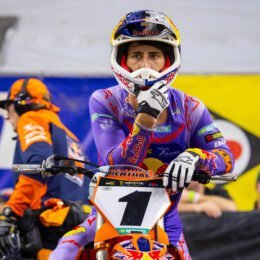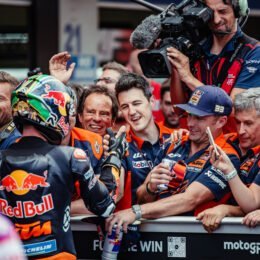BEHIND THE KTM MOTOHALL LEGENDS OF THE DAKAR EXHIBITION
30 YEARS OF KINI AND DAKAR
The Dakar Rally needs no introduction. It’s an incredible annual race of a million stories, and one that perhaps was ‘the making’ of KTM as we know it today. It is singly the most difficult and long, yet spectacular races you can take part in on a motorcycle, and one we all relish in following every January.

PC @FullGasCreative
But when did it all start for KTM? Roll back to the 1990s when an Austrian Motocross World Champion, Heinz Kinigadner, had discovered the world of rally despite his pre-conceptions about the discipline, as his competitive motocross career came to a close. ‘Kini’, as he’s affectionately known, convinced Stefan Pierer (KTM CEO) to have an official entry to build a team to compete at one of the toughest races on the planet. And we’re so glad he did.

PC @FullGasCreative
Since then, adventures have been a-many, thousands of stories created, and numerous legends have been made. KTM boasts 19 Dakar victories, with nine different winners and three continents raced as the event moved from Africa to South America to Saudi Arabia. 30 years on from Kini’s first official KTM entry and we are now celebrating ‘The Legends Of The Dakar’ in a new special exhibition in the KTM Motohall, Mattighofen – the home of KTM – and what a spectacle it is.
In preparation for the exhibition there was a lot of talk of which bikes should be on display; there was only space for so many – but with hundreds of stories from so many Dakar races there was a big choice to choose from – Kini’s 1995 Dakar bike, the LC4 that took the first victory with Fabrizio Meoni in 2001, that enormous twin-cyclinder LC8 in 2002, Richard Sainct’s Gauloises bike, Nani Roma’s Repsol colors in 2004, Cyril Despres’ bikes, Marc Coma’s bikes, the first 450 in the 690 chassis, the first 450 of the new era and so on and so on. It was a tricky choice, and that is testament to the sheer history of the race that KTM holds with both hands.

PC @FullGasCreative
One of the factors that was paramount to the success of the exhibition content was the explanation of this unique race – its history and its future – as well as finding untold stories that really bring visitors into the midst of the desert and mindset of a Dakar racer. In the end, with hours and hours of interview recorded, it was difficult to select the stories that would make the cut, but what an occasion it has been to talk to these super-human athletes that have endured experiences few will ever be able to understand. We asked them to dig deep as they reflected on years gone by and give us an insight into those times in the race where they really reached the human limit. All of the athletes could remember so many special moments, and perhaps now they reflect differently than they did when they’d first taken their victories and the feeling was ‘new’.

PC @FullGasCreative
Kinigadner competed at the Dakar seven times. His vision to race at an event when very little racing was happening globally, and one that had international appeal, became quite fundamental to the success of the Adventure bike models as KTM’s fortunes as a company began to change. His gear was minimalistic, as was the set-up back then, and tales of gearboxes in the sand, getting lost in some of the world’s untouched landscape, sleeping in the wilderness in a tent and the endurance required both mechanically and physically to complete the race were almost inconceivable – and actually, Kini could have talked for quite a few days to tell his story. Memories of the likes of Fabrizio and Richard reminded us of Dakar years past, and those athletes who hold an important place in the record books that maybe are becoming a little lost in time. It was an important occasion.
“In my time the Dakar was the biggest adventure you could have. Unbelievable landscapes, away from home, there was no telephone, you were really alone with your bike. This was wonderful,” said Kinigadner.
“Being part of this rally idea and rally activities really makes me a bit proud and happy. I’m thankful that I was allowed to be there for all of these stories – it would be easy to write a book! In January there is no other motorsport and everyone is watching this race. You show pictures at home from a landscape that every motorcyclist is dreaming of and this is what makes the Dakar so special,” continued the Austrian racer.

PC @SebasRomero
While the Dakar of today enjoys so much more global communication directly from the event with the technology that can project imagery around the world much faster than previously, the mystery of the race still remains. As we interviewed the likes of Cyril Despres and Marc Coma, both five-time Dakar winners who can now reflect on their fierce rivalry with a little more ease than perhaps 10 or so years ago, the stories of their time in Africa and South America were absolutely mesmerising. We built a picture of an era of the past, of serious competition, danger, and extremes that, from the warmth and calm of the interview studio, were hard to comprehend. Just finishing a Dakar is no mean feat, to win one, two or five is difficult to appreciate, as are the lengths they would go to ensure they were ‘the best’.

PC @FullGasCreative
Heading towards the more modern era, which has been even better-documented globally than previously, and with thanks to the support of Red Bull, the stories are of no less intensity. Matthias Walkner talks of how special it was to be an Austrian rider, on an Austrian bike with an Austrian sponsor, Sam Sunderland explains the emotion after recovering from a serious injury to take his victory in 2017, and Toby Price won a race with a broken scaphoid. They reel off the days and the riding with ease, but imagine it, getting on an Enduro bike, adding some weight, going to the desert, reading directions via some little icons (the roadbook) you’ve never seen before and riding your motorcycle for hundreds of kilometers at speed for around 14 days consecutively in extreme conditions you wouldn’t sunbathe in/go skiing in. It’s the ultimate test.

PC @SebasRomero
Arguably the vision of Kini some 30 years ago paved the way for a READY TO RACE mentality instilled within KTM and once the Austrian firm found its winning ways, there really was no stopping the orange team. There are so many variables within a Dakar that to win 19 times is incredible, especially with 18 consecutive wins from 2001-2019. The most recent victory, perhaps perfectly achieved for the 30-year celebration, was in January 2023 with Kevin Benavides. The Argentinian took the win from teammate Toby Price, although by the smallest of margins. 30 years ago the Dakar was so much the same as it is today, and yet so different.

PC @FullGasCreative
Find out more about the special ‘Legends Of The Dakar Exhibition’ by clicking here or visit the KTM Motohall in Mattighofen, Austria.


